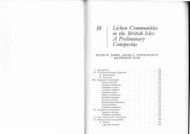You also want an ePaper? Increase the reach of your titles
YUMPU automatically turns print PDFs into web optimized ePapers that Google loves.
see Porpidia soredizodes<br />
40* Soralia mostly larger, rounded to irregular, even<br />
coalescing. Thallus commonly extensive<br />
Pertusaria<br />
41 Thallus K+ yellow with Atranorin<br />
GS Lecanora/PT2<br />
41* Thallus K- (possibly soralia K+ yellow) 42<br />
42 Medulla I+ blue GS Lecidea/PT5<br />
42* Medulla I- 43<br />
43 Thallus pale greenish, gray-greenish, slightly<br />
yellowish-green even almost gray, KC+<br />
yellow/KC-, <strong>of</strong> flat to convex areoles or fissured<br />
areolate, with defined soralia or in the center<br />
soon disintegrating into flat soredia. Usnic acid,<br />
Zeorine . Lecanora<br />
43* Thallus white to gray, KC- 44<br />
44 Thallus extensive, coherent, ± fissured, with large<br />
round soralia, <strong>of</strong>ten with clearly defined zones,<br />
gray to greenish prothallus .<br />
Pertusaria albescens<br />
44* Thallus without definite prothallus or with black<br />
prothallus GS Lecidea/PT 5<br />
Key VIIIc: Sterile Crustose <strong>Lichens</strong> on<br />
Bark<br />
1 Thallus sorediate . 2<br />
1* Thallus not sorediate 63<br />
2 Thallus C+/KC+ (yellow)orange or red . 3<br />
2* Thallus C- to C+ yellow, not KC+ orange or red<br />
(but in the case <strong>of</strong> Pertusaria amara KC+ violet,<br />
in Lepraria eburnea very fleeting reddish) 17<br />
3 Thallus usually yellowish, green-yellowish, grayyellowish,<br />
yellowish-green, or ochre, C+ yelloworange<br />
to orange .4<br />
3* Thallus C+ rose to red (orange-red) . 7<br />
4 Thallus finely isidiate, the isidia sometimes<br />
becoming partially sorediate .<br />
Pertusaria flavida<br />
4* Thallus not isidiate . 5<br />
5 Thallus with defined soralia, gray-white to pale<br />
yellowish, gray-yellowish to slightly greenish.<br />
Soralia pale yellowish. Arthothelin, Granulosin<br />
Thiophanic acid, Capistraton GS Lecidella<br />
5* Upper surface <strong>of</strong> the thallus generally soon<br />
entirely sorediate . 6<br />
6 Thallus/soredia ochre, pale yellow to pale<br />
yellow-greenish, even pale brownish-green,<br />
sometimes with blackish prothallus, K-, C+<br />
orange, UV+ (brown)orange, without<br />
crystallizing needles. Soredia -50 µm.<br />
Isoarthothelin, Thiophanic acid .<br />
Pyrrhospora quernea<br />
6* Thallus/soredia pale yellow-greenish, pale<br />
greenish, rarely partially also pale ochre-yellow,<br />
sometimes with whitish, rarely bluish prothallus,<br />
K+ yellowish, C+ yellow-orange, UV-/UV±<br />
violet, in the herbarium <strong>of</strong>ten covered with the<br />
finest crystallizing needles. Soredia -50 µm.<br />
Usnic acid, Thiophanic acid, Zeorine, ±<br />
Arthothelin. . Lecanora expallens<br />
7 Thallus partially orange, there K+ red, otherwise<br />
pale greenish, light gray, greenish-gray, K-,<br />
extensive, coarsely granular, with greenish-white,<br />
even partially orange colored, at first convex,<br />
then fleck like to coalescing soralia, P-. Soredia<br />
fine, -25 µm. Gyrophoric acid, anthra-quinone<br />
Trapeliopsis pseudogranulosa<br />
7* Thallus not flecked orange. K-/K+ slightly<br />
yellowish 8<br />
8 Thallus permanently finely isidiate in the center,<br />
light gray, light greenish-gray to whitish. Isidia<br />
delicate, soon disintegrating into whitish to<br />
greenish-gray soredia, spherical to mostly<br />
cylindric (to coraloid ), -1(0.2)mm thick.<br />
Without well defined soralia, <strong>of</strong>ten with whitish<br />
prothallus. UV+ blue-white. Gyrophoric acid .<br />
Ochrolechia subviridis<br />
8* Thallus without isidia, clearly sorediate . 9<br />
9 Thallus P+ yellow(orange), C+ (<strong>of</strong>ten fleeting)<br />
red, with alectorialic acid . 10<br />
9* Thallus P-, without Alectorialic acid, with<br />
Gyrophoric or Lecanoric acid . 12<br />
10 Thallus <strong>of</strong> mostly scattered, ascending, convex,<br />
<strong>of</strong>ten indefinite squamules with lip soralia,<br />
whitish Hypocenomyce leucococca<br />
10* Thallus not <strong>of</strong> ascending squamules 11<br />
11 Thallus areolate to indefinite (in the substrate),<br />
yellowish-gray to slightly ochre or light gray,<br />
with diffuse yellowish, pale yellowish-green,<br />
yellowish-brown (in the herbarium <strong>of</strong>ten rose<br />
colored) soralia, K+ yellow. Soredia 20-50 µm<br />
Hypocenomyce sorophora<br />
11* Thallus granular, thin to thick, irregularly finely<br />
mealy sorediate disintegrating, dark graygreenish<br />
to dark brown-gray, thin to thick, K-.<br />
Soredia 12-22 µm thick Buellia pulverea<br />
12 Thallus with lichexanthon, gyrophoric acid, thin,<br />
smooth, whitish. Soralia UV+ orange, flat to<br />
slightly concave, rounded, whitish, cream colored<br />
to slightly greenish, 0.3-0.7 mm wide, soredia -70<br />
µm . Ochrolechia arborea<br />
12* Thallus without Lichexanthon, UV-/± white.<br />
Soralia ± flat to convex 13<br />
13 With Lecanoric acid., C+ (carmine)red reaction<br />
above all in the medulla/in the soralia. Thallus<br />
with whitish, shiny, <strong>of</strong>ten zoned prothallus,<br />
smooth to unevenly warty, toward the margin<br />
mostly with fissures, fissured to the thallus<br />
center, silver-gray, gray-white, or gray. Soralia<br />
whitish, convex (to hemispherical), -1.3(1.8) mm<br />
wide, also coalescing. Very <strong>of</strong>ten in association<br />
with Pertusaria coccoides or flavida .<br />
Pertusaria hemisphaerica<br />
13* With Gyrophoric acid, C+ (rose- to orange)red<br />
reaction in the soralia/ in or upon the bark.<br />
Thallus without, rarely with whitish prothallus.<br />
Soralia flat to convex . 14<br />
60





